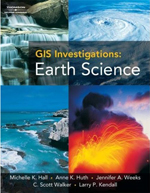 GIS Investigations: Earth Science allows students to use powerful, state-of-the-art GIS software and data backed by current scientific research to investigate a wide variety of topics in the Earth Sciences. Scientists use GIS technology as a tool for organizing, visualizing, and analyzing scientific data. This real-world data provides new insights into the traditional concepts taught in the Earth Science classroom, and motivates students to “discover” key scientific concepts. The investigations are written by scientists and educators in an engaging style, and have been extensively tested, and are in use in classrooms across the country. These investigations do not require teachers or students to have previous experience with GIS software. The extensive data sets offer many opportunities for students’ independent, open-ended exploration – to experience the thrill of working like real scientists.
GIS Investigations: Earth Science allows students to use powerful, state-of-the-art GIS software and data backed by current scientific research to investigate a wide variety of topics in the Earth Sciences. Scientists use GIS technology as a tool for organizing, visualizing, and analyzing scientific data. This real-world data provides new insights into the traditional concepts taught in the Earth Science classroom, and motivates students to “discover” key scientific concepts. The investigations are written by scientists and educators in an engaging style, and have been extensively tested, and are in use in classrooms across the country. These investigations do not require teachers or students to have previous experience with GIS software. The extensive data sets offer many opportunities for students’ independent, open-ended exploration – to experience the thrill of working like real scientists.
The Data Detectives series requires ArcGIS version 9.x software from ESRI, Inc. ArcGIS software is not included in the package, and must be licensed separately.
Module 1 – Dynamic Earth Contents
Students explore plate tectonics – the process that governs the large-scale structure of Earth’s surface – by examining the relationships between earthquakes, volcanoes, and plate boundaries
National Science Education Standards Alignment
Module 2- The Ocean Environment Contents
Students explore the dynamic forces that shape the ocean basins, drive global ocean currents, and control marine productivity.
National Science Education Standards Alignment
Module 3 – Tropical Cyclones Contents
Students explore the occurrence, characteristics, and hazards of tropical cyclones by examining global data sets of storms occurring during the past century.
National Science Education Standards Alignment
Module 4 – Where’s the Water? Contents
Students examine the movement of water through the hydrological cycle with an emphasis on factors controlling precipitation, surface flow, and groundwater recharge, and the importance of wise water management.
National Science Education Standards Alignment
